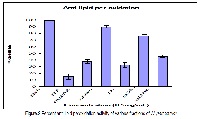Non-Toxic Fractions of Hypericum perforatum and Hypericum oblongifolium Inhibit Protein Glycation, Free Radicals Production and Lipid Peroxidation in vitro
Keywords:
Medicinal plants, Medicinal plantsantiglycation, Hypericum perforatum and Hypericum oblongifolium, cytotoxicityAbstract
In this study, the biological activities of the crude extracts/fractions of two medicinally important plants Hypericum perforatum and Hypericum oblongifolium were investigated for their potential antiglycation, antioxidant, anti lipid peroxidation and cytotoxicity studies. In antioxidant 1,l-Diphenyl-2-picryIhydrazylradical (DPPH) assay, aqueous and n-Butanol fractions of H. perforatum exhibited significant antioxidant potential with IC50 values 91.443±2.052 and 119.781±2.821 µg/mL respectively while n-Butanol fraction of H. oblongifolium also showed moderate activity with IC50 value 215.375±3.562 µg/mL. The n-Butanol fraction of H. perforatum showed 63.466% activity and aqueous fraction showed 52.901% inhibition in lipid per oxidation assay while H. oblongifolium fractions, dichloromethane, methanol and n-Butanol exhibited 67.206%, 61.874% and 54.219% inhibition, respectively. The n-Butanol and n-hexane fractions showed 57.250% and 50.018% inhibitory activity against protein glycation. All fractions from both species were found to be non-toxic largely in cytotoxicity assay except for n-hexane fraction of H. perforatum and dichloromethane fraction of H. oblongifolium which showed mild cytotoxicity with IC50 values of 21.70±0.237 µg/mL and 26.612±0.014 µg/mL respectively as compared to cycloheximide used as standard (IC50 = 0.073±0.1 µg/mL). The study concluded that the aqueous and n-Butanol fractions of both the species possess promising antioxidant, antiglycation and anti lipid per oxidation activities with no toxic effects in vitro.
References
Halliwell B, Gutteridge, JMC. Free radicals in biology and medicine, 3rd ed., Oxford: Oxford
Univ. Press; 1999, pp. 105–245.
- Young IS and Woodside JV. Antioxidants in health and disease, J Clin Pathol, 2001; 54:
-186.
- Souri E, Amin G, Farsam H, Barazandeh TM, Screening of antioxidant activity and phenolic content of 24 medicinal plant extracts, DARU, 2008; 16: 83-87.
- Heinecke JW, Oxidative stress: new approaches to diagnosis and prognosis in atherosclerosis, Am J Cardiol, 2003; 91: 12-16.
- Mir ZG, Lepakshi MB, Farhan A, Anand KKi, Insaf AQ and Irfan AG, Evaluation of Abelmoschus moschatus extracts for antioxidant, free radical scavenging, antimicrobial and antiproliferative activities using in vitro assays BMC Complementary and Alternative Medicine, 2011; 11: 64
- Cakir A, Mavi A, Dirim Yi A, Duru ME, Harmandar M, Kazaz C, Isolation and characterization of antioxidant phenolic compounds from the aerial parts of Hypericum hyssopifolium L. by activity-guided fractionation, J. Ethnopharmacol, 2003; 87: 73–83.
- Suntar, IP, Akkol EK, Yilmazer D, Baykal, T Kirmizibekmez H, Alper M, Yesilada E, Investigations on the in vivo wound healing potential of Hypericum perforatum L. Journal of Ethnopharmacology, 2010; 127: 468–477.
- Farheen S, Ahmed E, Afza N and Malik A, Phytochemical investigations on Hypericum oblongifolium, J Chem Soc (Pakistan), 2005; 27: 533.
- Farheen S, Ahmed E, Malik A, Afza N, Lodhi MA and Choudhary MI, Hyperinols A and B, chymotrypsin inhibiting triterpenes from Hypericum oblongifolium, Chem Pharm Bull, 2006; 54: 1088.
- Saddiqe Z, Naeem, I, Mughal T, Taskeen, A and Mubeen H, Characterization of flavonoid aglycones in aerial parts of Hypericum oblongifolium L. Asian Journal of Chemistry, 2011; 23: 939-940.
- Khan AU, Khan M, Subhan F and Gilani AH, Antispasmodic, bronchodilator and blood pressure lowering properties of Hypericum oblongifolium--possible mechanism of action. Phytother Res, 2010; 24: 1027-32.
Lee SK, Mbwambo ZH, Chung H, Luyengi L, Gamez EJ, Mehta RG, Kinghorn D, Pezzuto JM, Evaluation of the antioxidant potential of natural products, Comb Chem High Throughput Screen, 1998; 1: 35-46.
- Choudhary MI, Abbas G, Ali S, Shuja S, Khalid N, Khan KM., Atta-ur-Rahman and Basha FZ, Substituted benzenediol Schiff bases as new promising antiglycation agents, J Enzyme Inhib Med Chem., 2011; 26: 98-103.
Matsuda H, Wang T, Managi H, Yoshikawa M, Structural requirements of flavonoids for inhibition of protein glycation and radical scavenging activities. Bioorganic & Medicinal Chemistry; 2003; 11: 5317-5323.
Matsuura N, Aradate T, Sasaki C, Kojima H, Ohara M, Hasegawa J and Ubukata M, Screening system for the Maillard reaction inhibitor from natural products extracts. J. of Health Science; 2002; 48: 520- 526.
Buege JA., Aust SD, Microsomal lipid peroxidation methods, Enzymol, 1978; 52: 302 – 310.
Jia W, Gao W, Tang L, Antidiabetic herbal drugs officially approved in China. Phytother Res, 2003; 17: 1127–1134.



